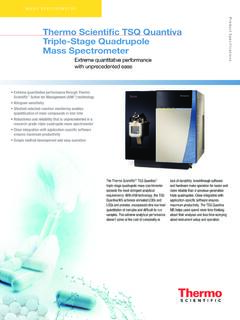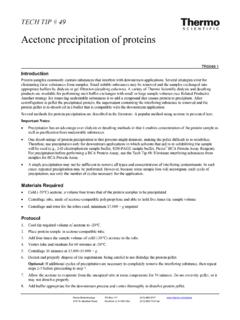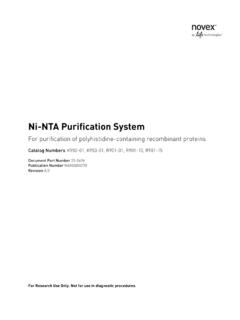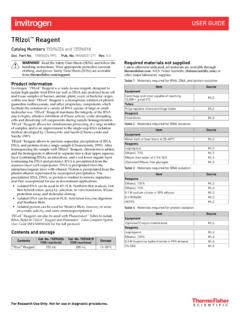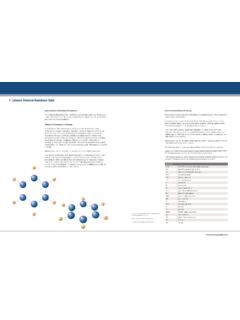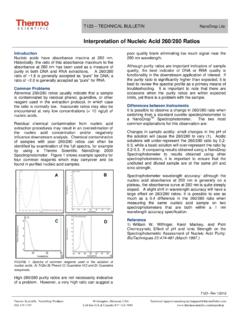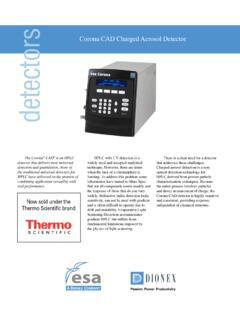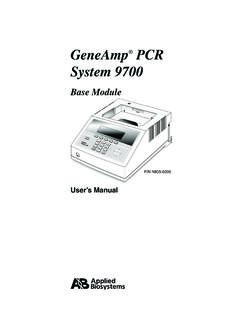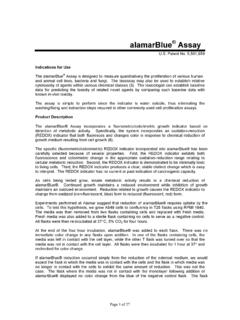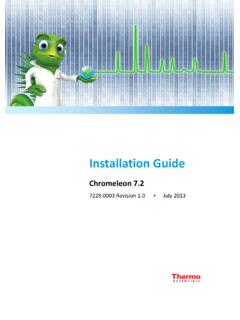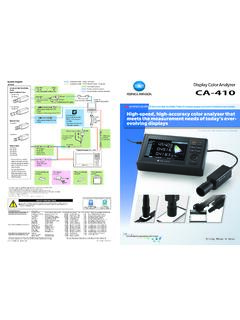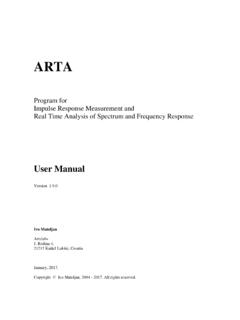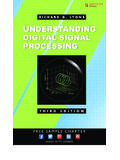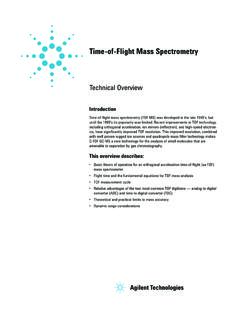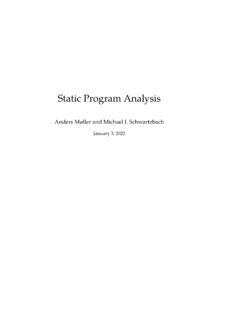Transcription of 3500 and 3500xL Series Genetic Analyzers
1 SPECIFICATION SHEET 3500 and 3500xL Series Systems3500 and 3500xL Series Genetic AnalyzersKey features 8-capillary 3500 System and 24-capillary 3500xL System Advanced thermal system design improves temperature control for demanding DNA fragment analysis applications Single-line 505 nm, solid-state long-life laser utilizes a standard power supply and doesn t require heat removal Significantly improved signal uniformity from instrument to instrument, run to run, and capillary to capillary Powerful, integrated data collection and primary analysis software provide real- time assessment of data quality Radio frequency identification (RFID)
2 Technology records key consumable administrative information, tracks usage and warns users of replacement status Advanced multiplexing capabilities for DNA fragment analysis with up to six unique dyes Superior application flexibility one array and one polymer used for most applications Simple setup, operation and maintenance the easiest-to-run, easiest-to-own DNA sequencer to date Validated for use with Applied Biosystems MicroSEQ identification and forensics applicationsOverviewThe Applied Biosystems 3500 Series Genetic Analyzers are specifically designed to support the demanding performance needs of validated and regulated environments while retaining the unsurpassed application versatility that life science researchers expect.
3 The 8-capillary 3500 and 24-capillary 3500xL Genetic Analyzers continue to set the standard in capillary consumables The following consumables are for use on the 3500 Series Systems: Capillary arrays: The internally uncoated capillaries are supplied in assemblies of 8 or 24 capillaries per array, with a built-in frame for easy installation. Arrays are available in 36 cm and 50 cm capillary lengths to support multiple applications and run System components The Applied Biosystems 3500 and 3500xL Genetic Analyzers are supplied as follows: Capillary electrophoresis instrument 8-capillary ( 3500 System) or 24-capillary ( 3500xL System) array and polymer DNA sequencing and/or fragment analysis reagents and consumables for system qualification Dell computer workstation with flat-screen monitor Integrated software for instrument control, data collection, quality control and auto-analysis of sample files for basecalling and fragment sizingTable 1.
4 Sequencing throughput and performance module4,5 Throughput2 ConfigurationPerformanceAverage run time (minutes)Average throughput, 3500xL (samples/day)Average throughput, 3500 (samples/day)Array separation distance (cm)Polymer typeResolutionrange in 90% ofsamplesKB QV20 CRL3in 90% ofsamplesRapidSeq36_POP7 30 1,104 36836 POP- 7 40 to 500 600 FastSeq36_POP7 60 552 18436 POP- 7 40 to 600 750 RapidSeq36_POP4 45 720 24036 POP- 4 40 to 400 400 RapidSeq36_POP6 65 504 16836 POP- 6 40 to 500 600 BDX_RapidSeq36_POP7 30 1,104 36836 POP- 7 40 to 500 600 BDX_FastSeq36_POP7 60 552 18436 POP- 7 40 to 600 750 BDX_RapidSeq36_POP4 45 720 24036 POP- 4 40 to 400 400 BDX_RapidSeq36_POP6 66 494 16436 POP- 6 40 to 500 600 RapidSeq50_POP7 40 840 28050 POP-7 40 to 550 500 StdSeq50_POP6 135 240 8050 POP-6 20 to 600 600 FastSeq50_POP7 65 504 16850 POP-7 40 to 600 700 StdSeq50_POP7 125 264 8850 POP-7 40 to 700 850 ShortReadSeqPOP7 30 1.
5 104 36850 POP-7 40 to 400 300 RapidSeq_BDX_50_POP7 40 840 28050 POP-7 40 to 550 500 StdSeq_BDX_50_POP6 140 240 8050 POP-6 20 to 600 600 FastSeq_BDX_50_POP7 65 504 16850 POP-7 40 to 600 700 StdSeq_BDX_50_POP7 125 264 8850 POP-7 40 to 700 850 ShortReadSeq_BDX_POP7 30 1,104 36850 POP-7 40 to 400 300 MicroSeq_POP7 125 264 8850 POP-7 40 to 700 850 MicroSeq_POP6 135 240 8050 POP-6 20 to 600 6001. The specifications are reported using long-read sequencing standard. 2. Throughput (samples/day) is determined by the total number of samples that can be run in 23 hours (allows time for sample preparation, instrument maintenance and warm-up).
6 3. QV20 CRL is defined as the longest uninterrupted segment of bases with an average of QV 20, calculated over a sliding window of 21 base pairs. 4. The fast ShortReadSeq module collects 300 bp in 30 minutes for operations requiring short verification of sequence content ( , clone QC verification).5. BDX classified run modules are optimized with the 3500 Series Systems to obtain more usable data when sequencing reactions are purified using the Applied Biosystems BigDye XTerminator Purification or 24-capillary array505 nm solid-state laserPolymer pumpPerformance Optimized Polymer (POP) pouchCathode Buffer Container (CBC)Anode Buffer Container (ABC)96- and 384-well plates (8-tube strips also available) methodologies.
7 The 36 cm and 50 cm arrays have been optimized for many applications for use with POP-7 Polymer, POP-6 Polymer, and POP-4 Polymer run modules. This provides users with flexibility to select their ideal run times and read length needs. The 3500 and 3500xL capillary arrays are specified for 160 injections. POP-7, POP-6, and POP-4 Performance Optimized Polymers: The 3500 and 3500xL POP-7, POP-6, and POP-4 polymers are designed in ready-to-use, load-and-run pouches. POP polymers are available in three sizes: 96 samples (a maximum of 12 injections on the 3500 System or 5 injections on the 3500xL System), 384 samples (a maximum of 60 injections on the 3500 System or 20 injections on the 3500xL System), and 960 samples (a maximum of 120 injections on the 3500 System or 50 injections on the 3500xL System).
8 The pouch has adequate polymer to support the stated number of samples or injections, plus additional volume for initial setup and installation operations. Most applications may be run with POP-7 polymer, along with the 50 cm array or 36 cm or below the operating temperature of 25 C, all the polymer types are specified to be used on the instrument for up to 14 days or when the specific injection limits are reached, whichever comes first. If the operating temperature is above 25 C, POP-7 polymer is specified to be used on the instrument for up to 7 days or when the specific injection limits are reached, whichever comes and conditioning reagent consumables: Similar to the 3500 System polymer pouches, the 3500 Series Genetic analyzer Cathode Buffer, Anode Buffer, and Conditioning Reagent are designed for ready-to-use, load-and-run installation.
9 Consumable containers are disposed of when the maximum number of samples has been processed. Cathode Buffer Container (CBC): Prefilled container with 1X Buffer to support all electrophoresis applications. The container has two separate compartments; the left side contains the cathode buffer for electrophoresis, and the right side contains spent polymer waste from the capillary wash between injections. The CBC is specified to be used on the instrument for up to 14 days after first installation (or a maximum of 240 injections on the 3500 System, or 100 injections on the 3500xL System, whichever comes first).
10 Table 2. Fragment analysis throughput and performance nameThroughput1 ConfigurationAverage run time (minutes)Average throughput, 3500 (samples/day)Average throughput, 3500xL (samples/day)Array separation distance (cm)Polymer typeFragAnalysis50_POP7 40 840 280 50 POP-7 FragAnalysis50_POP6 100 336 112 50 POP-6 LongFragAnalysis50_POP7 125 264 88 50 POP-7 HID36_POP4 35 960 320 36 POP-4 HID36_POP4 26 424 1,272 36 POP-7 SNaPshot50_POP7 30 1,104 376 50 POP-7 FragAnalysis36_POP7 30 368 1,104 36 POP-7 FragAnalysis36_POP6 60 184 552 36 POP-7 FragAnalysis36_POP4 35 312 936 36 POP-4 Module namePerformanceGeneralSizing precision3 of 100% of alleles in 90% of samples Multirun sizing4 of 100% of alleles in 90% of samplesResolution range2 in 90% of samplesLargest fragment collected in 90% of samples50 400 bp401 600 bp601 1,200 bp50 400 bp401 600 bp601 1,200 bpFragAnalysis50_POP7 40 to 520 600 < < NA <1 bp <2 bp NA FragAnalysis50_POP6 20 to 550 600 < < NA <1 bp <2 bp NA LongFragAnalysis50_POP7 40 to 700 1.
